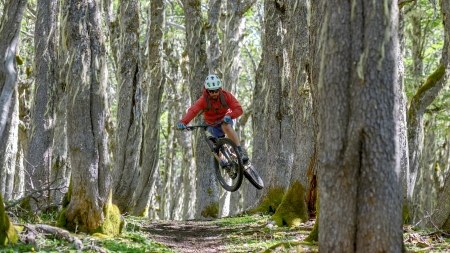Trails for Everybody
An interview with Gabo Benoit, trail advocate and mountain-bike mayor of Coyhaique, Chile.
Despite the pandemic, Gabo Benoit hasn’t stopped advocating for trails around his home in Coyhaique, Chile. Writer Teal Stetson-Lee caught up with Gabo via Zoom, to hear more about his recreation-based conservation efforts and the evolution of mountain biking in the Aysén region.
Listen to the interview or read a transcript of it below, edited and condensed for clarity.
My name is Teal Stetson-Lee, and I’m joined by Gabo Benoit, in Coyhaique, Chile. Originally from Santiago, Gabo runs a mountain-bike and fly-fish guiding business, guest lodge and bike shop in the Aysén region of southern Chile alongside his wife, Carmen, their two young daughters and son, his sister, Cami, and two other mountain-bike guides, Juan Eduardo Zamorano Vera and Edecio Vasquez. He has also created a strong relationship with the local trail-building crew called Huemules Trails as well as a kids’ mountain-biking school.
I first met Gabo in February of 2019 at his home in Coyhaique, where he was cheering on his daughters, 7-year-old Amalia and 5-year-old Maite, as they fearlessly rode their bikes off tiny wooden jumps in the backyard. It was a fitting intro, and the whole family immediately welcomed us.
As it turns out, Gabo also has a history in professional mountain biking as a national champion downhill racer and Enduro World Series competitor. His racing experiences reflected his unconventional approach to life and served as a catalyst into his current roles as a mountain-bike guide and Patagonia brand ambassador in Latin America. Gabo’s dreams and goals have always been bigger than bike racing, having dedicated himself to strengthening his community and homeland against economic hardship and environmental destruction.
Gabo and I share a deep interest in the convergence of outdoor recreation, conservation and community, and we’re glad you’re all joining us as we continue that conversation. Welcome.
Teal Stetson-Lee: Hello, Gabo! It’s great to see you. Where are you right now? And what are you up to?
Gabo Benoit: Well, well. Hello, Teal. Nice to see you too. I’m here in the store. The store is now closed for two hours. I’m in Coyhaique. It’s a beautiful day outside. I’m great.
TSL: Wonderful! So, give me a little bit of background on yourself in a few sentences.
GB: A little bit background, like little words for me? Adventure! I don’t know what else. My life is an adventure. My whole life has been like that, taking things in one minute and trying to make it out and always focusing on what I love in my life: wheels, nature and conservation. I think they’re so important, those things for me.
I started coming down here to Coyhaique and Patagonia [the region] when I was really little. I was like 8 years old, and I was involved in fly fishing. An uncle of mine told me how to fly fish, and that was a real connection with nature and everything. I think my uncle was not so happy because this little kid was here every summer, trying to go fishing.
From 4 years old, I was involved with two wheels. I started racing dirt bikes, motocross. My father is a fanatic about rally cars and everything with wheels. Bikes and mountain bikes were in me since I was 4, but the connection with nature and trying to see how important it was to save our environment and our animals, that happened around fly fishing for sure. When I made my first catch and release, I understood we must have respect.
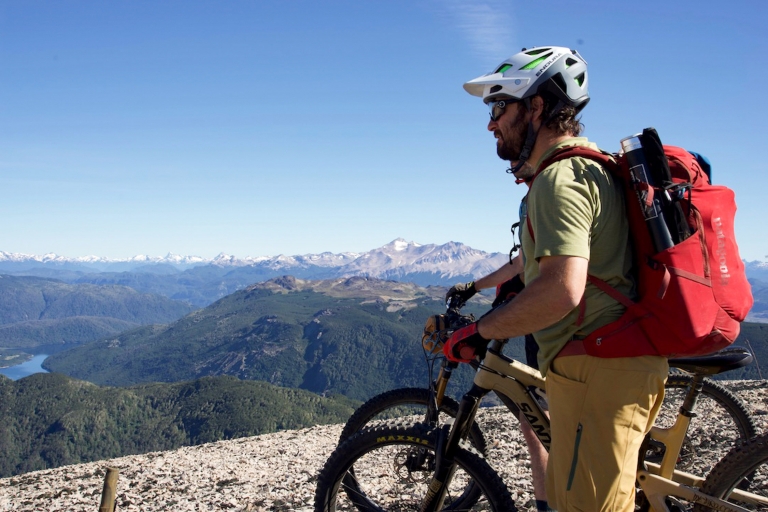
When mapping new trail networks, it always helps to have a view. Gabo and Sam Appelbaum survey some possible routes before starting another long, long descent. Photo: Max Wittenberg
TSL: Wow, that’s amazing, to be introduced to that at a young age. Well, speaking of a young age, how are your daughters now? Are they still riding off mountain-bike jumps, and how big are those jumps now?
GB: No, now we have a big pump track here in the lodge, and we have a course with little stairs and jumps and everything. They train like two days a week here with the teachers that we have in the school. They’re growing a lot, a lot. They are still good riders. They’re awesome. And we have Gabito, who’s one year and a half.
TSL: He is your new son?
GB: Yeah! He’s using the push bike now.
TSL: I guess they’re taking after their Papa.
GB: Yeah, yeah. I guess so!
TSL: And you had a successful career as a professional mountain biker. How did you get into mountain biking?
GB: Well, I got into mountain biking when I was little, but not racing too much. I used to race a lot of dirt bikes, and I was pretty good. I got in an accident when I was 16 and broke two vertebrate, so I stopped racing dirt bikes, and I say to my mom, “OK, Mom. I’m gonna sell my motorcycles and buy a downhill bike.”
I didn’t race for too many years; I think five years in total between junior category and elite. I like to push a lot. When I do something, I want to do it good. That’s the way for me. I want to be professional in what I do.
It was hard because in Chile, families tend to be super traditional. So, this 18-year-old guy who want to be a professional mountain biker and fly-fishing guide—this was rare. But my mother always supported me. I told her, “Mom, I don’t wanna study. I wanna be a professional.”
“You want to be a professional?” she said. “OK, I’m going to support you. I will not give you money to race, but you must be the best. If you want to go training, I will take you there, but you must be the best.”
I was racing half the year, and the other half I was fly-fish guiding down here in Patagonia.
A big part of my family did not agree with this. But of course, sports give me a lot of things, taught me that nothing was impossible. Sport showed me how to set steps and go over those steps. That was something very important in my life.
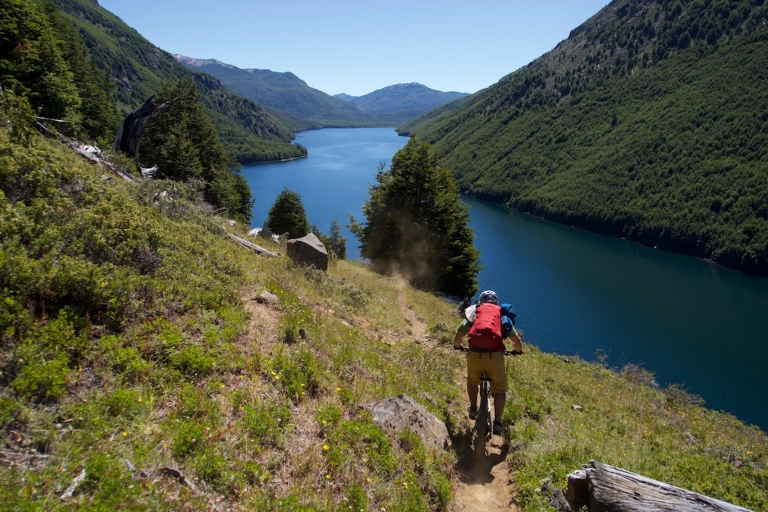
The Lago Largo trail is remote and sees almost no traffic besides wildlife and the occasional equestrian. Gabo descends toward the lake—likely the first time this trail has ever seen mountain-bike tires. Photo: Max Wittenberg
TSL: That drive from your sports culture and mountain biking has translated into where you are now with all your ambitions?
GB: Yes. I retired in 2002, as the number one in Chile, but maybe if I hadn’t, I could be in the World Cup. But I was very realistic about that; it was super hard to live on mountain biking in Chile. There was no support, there was nothing.
But I have other things here like guiding, fly fishing, that gave me that connection with nature and that I could live on. And after I retired from mountain biking, I didn’t ride for maybe 10 years.
Then one day, after I was married to Carmen, I said, “OK, I want to stop fly-fish guiding a little bit, and I want to start mountain biking again.” And I saw that where I live in Coyhaique, there was a lot of opportunities to create something with mountain bikes. I had all this experience taking care of the fly-fishing clients, so I used that experience and started to make mountain-bike groups and develop some trails. And that started working. When I first started, everybody looked at me and said, “What are you doing? You have been guiding for 15 years, and now you’re gonna guide mountain biking? There’s nothing here. Are you crazy?”
“Yeah, I’m crazy, but I believe in this.” And now our business is 100 percent about mountain biking. The lodge is focused on mountain biking. We have the bike shop. We have the mountain-bike school. We support the trail-building crews. I realized one thing that I really, really love is mountain biking. And now, I have more support than when I was racing. It’s my passion. Now, I live for mountain biking.
TSL: That’s neat to hear about that evolution in your career and part of that support has been the Patagonia brand. How did that relationship come about?
GB: That relationship started about eight years ago when I was fly fishing. We made a video down south here, with my dog and a really crazy crew of friends. We went exploring where nobody goes, and a big relationship started. Patagonia is a great brand, and it’s so cool that they are not interested in the World Championship but rather people who take care of what we have around us. For me, Patagonia [the brand] has been crucial. It’s awesome. I’m not in the good shape, but I love mountain biking, so they support me. That’s where you understand that they’re thinking about other things. We want to save our planet.
Where I live, I see that there are not too many opportunities for a lot of kids to go and study outside, but I saw the opportunities I have here without being a local. There’s a whole new crew of kids that are mountain biking now. Of course, they wanna be racers, but I tell them, “Hey, man, you could live for this, but it’s not all racing, so racing is not everything. This is a lifestyle, and if you love mountain biking, there’s a lot of ways to live on it. There are so many things beyond racing. It’s awesome, but there’s a lot of sacrifice behind that—a lot.”
TSL: I love that, Gabo. I can relate to that, that dream of being a professional athlete that kids have. And you’re sharing with them new ideas about what you could do with mountain biking and how you could diversify and still hold that as the passion that is your compass for what you’re doing with your life.
That actually gets me into the next question I have for you, about mountain biking in Chile. How would you describe the culture of mountain biking in Chile right now?
GB: I think it’s expanding a lot. It’s becoming a lifestyle. Of course, there’s a lot of racing, but if you go to a mountain-bike race, when it’s over, everybody is with their families, everybody is enjoying together. I think it’s a different way of racing, a mix of racing and lifestyle.
I can see in our business that mountain biking is becoming a lifestyle. A lot of groups, they don’t race, but they have all the same T-shirts, their groups have a name, and they go out together every weekend or three times a week. That’s culture.
We have an amazing, amazing country. We have a lot of mountains, a lot of mountains, and where I live, in Aysén, mountain-bike culture is new. Not more than 10 years.
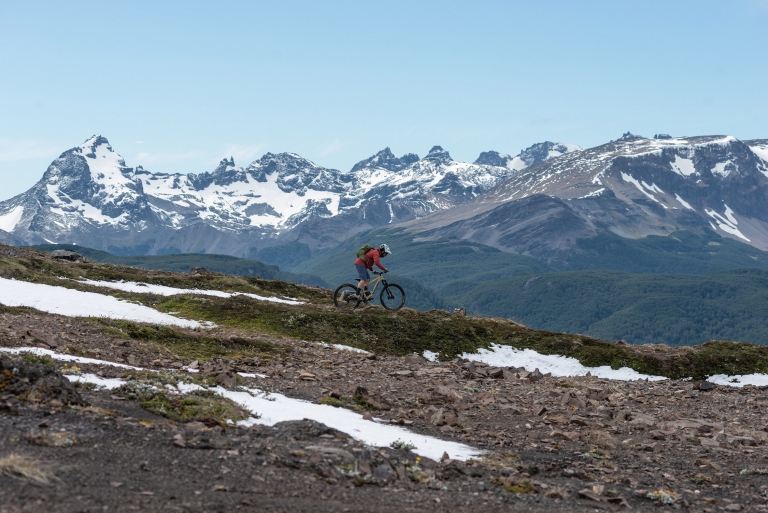
Despite being one of the youngest towns in the Aysén region of southern Chile, Coyhaique pretty much has it all: beaches to the west, high desert to the east, huge forests in the foothills and many, many mountains in between. Photo: Martin Garcia de la Huerta
TSL: Tell me more about where you live, for those who are listening. Tell us about the Aysén region. What is it like?
GB: First, the Aysén region is one of the largest regions in Chile. We have everything. We have from the sea to the border with Argentina, where it’s super dry. We have rain forest. We have ice fields. We have a lot, a lot, a lot of lakes. We have everything in one region. It’s awesome. It’s beautiful.
We are a ways from Santiago—about 1,000 miles [1,600 kilometers] south of Santiago. You could get here on a straight flight that is about two-and-a-half hours. As a region, it’s super new. The city of Coyhaique is maybe 100 years old. It’s hard here, very windy and cold. Living here was not easy in those early years. But Coyhaique has everything. You go east and you have the flat land, which is drier. You go west and you’ve got the rain forest. Mountains are great. We have big forest. The dirt is awesome. We have grip all year.
TSL: I have been fortunate enough to see a little bit of your amazing region, and I love hearing you describe it. I am curious about a lot of the trails you’re building and riding. They’re old resource-extraction roads, maybe even generational Indigenous pathways, and I want to know, how do trails fit into the culture and history of the Aysén region?
GB: Well first, the main activity in the Aysén region for a lot of years, and one of the main activities now, are cows or other farm animals. So, there are a lot of trails. And the locals, when they raise cattle and have to move them to Coyhaique, sometimes it’d take three months getting all those animals to the place where they sell them. All those trails are there in the mountains. Today, they bring a truck and put all the cows in the truck.
We have been making the long process of scouting all—not all, but part—of those trails and trying to clean them up and use them. They have a big history.
Another thing that we have been doing. There was a lot of wood extraction in the mountains, so a lot of places have lots and lots of fire roads, and we have been working on making trails over those fire roads. We have a long ways to go; we’re just starting. I know that we have maybe 10, 20 years more, right? The next generation is going to have a lot of trail, but they’ll still have to work for them. But there are endless possibilities here to make good trail systems—not easily, but they might not have to build from zero.
There are a lot of people that live in the mountains now that take out firewood. In La Gloria (a large, privately owned forested area outside of Coyhaique historically used for firewood cutting), there is one guy who bought a little mountain bike because he sees us every day riding our bikes. So, he decides to buy a bike to carry his chainsaw for cutting. But that’s the first step. Now, he’s riding a mountain bike to go make firewood; maybe in two years, he’ll have more attention for the trails.
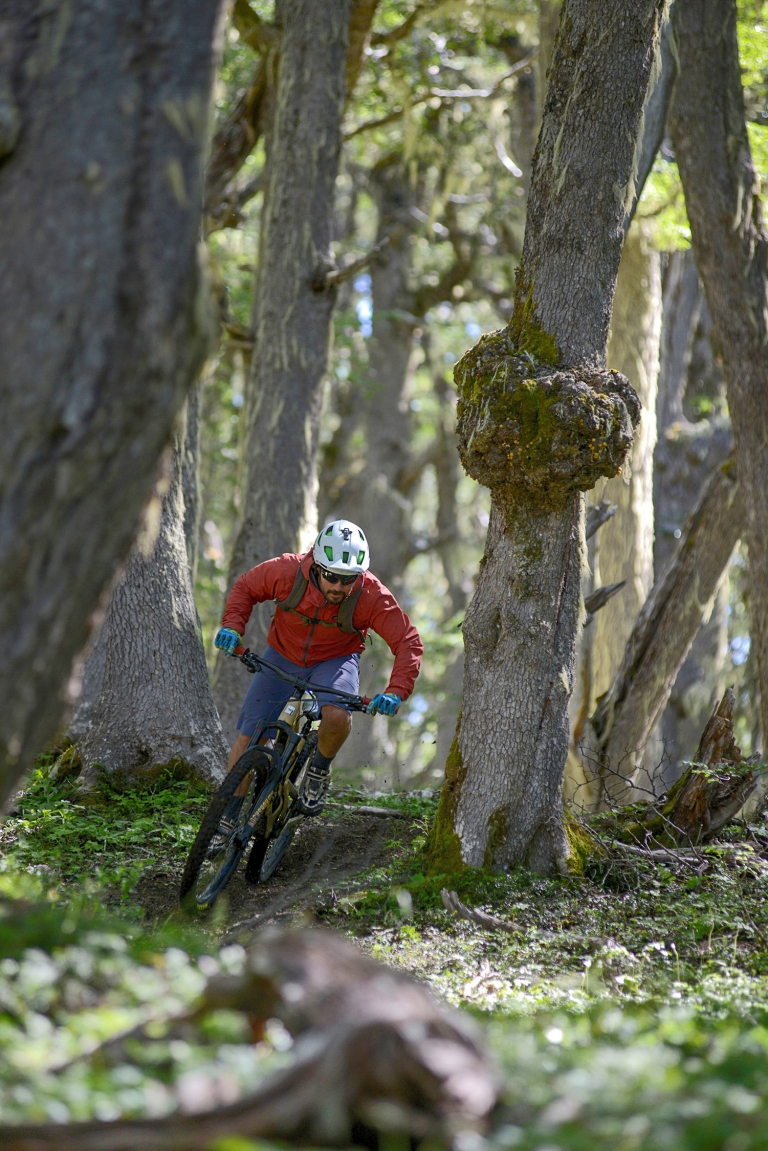
One “burl-y” tree line. Gabo hammers a corner under some arboreal oddities in the forests around his home. Photo: Martin Garcia de la Huerta
TSL: You’re inspiring locals to think about their own lifestyle and incorporate mountain bikes into what they’re doing.
GB: Yes, firewood here is important for a lot of people because they have made their living about that. But those people … they love the mountains. They live in the mountains, so if you could give them another way to conserve and to live in the mountains, I think that’s the key. That’s what I want to work for, how to give value to that. How to show them that maybe instead of cutting the trees, let’s take care the trees. That’s our vision.
TSL: I know one of your passions is growing outdoor recreation as an economic force in your area, maybe into something people will want to do more than collecting firewood or some of the other extractive industries in your area. Tell me, what has motivated that push from you to try to increase outdoor recreation?
GB: Well, first, I want to say we always use our mountain-bike tours to open these places. A lot of the local people may not agree with us because we’re paying the owners of these farms for access. Most of these places, they aren’t open to everybody. The local people don’t understand that my vision is like, OK, let’s go in with the tours first. Let’s show them the mountain bikers can conserve, that they can live with mountain biking and mountain bikers are not so bad. Then the owners agree with us and say, “OK, let’s open it now. Let’s be part of the trail system for the community.”
We are always thinking about opening these places in the future to everyone, but you have to understand that you’re going on a mountain bike into a place where people have never see a mountain bike. So, we don’t want to go in as an invasion; we want to go little by little, and then that man you saw cutting firewood is now riding a mountain bike, and the owner of that big farm now wants to build more trails. Then we’re ready to open it. Because we know that we could handle that.
Sometimes what happens here in Coyhaique is that owners of farm give a space to make some trails, but nobody take cares of them. Most of the places we use, I pay for the access and build the trails—so, I was pretty much paying to use my own trails. And people ask me, “Hey, but how is that your business?”
Well, I know that this is not a business, of course. But I have to do it. This is the way to show the owners that we can make something, because we have to start conservation in all these big private farms that are getting exploited. We have to change those owners, show them how to do conservation. Sometimes to a farmer, conservation sounds like, “Whoa, no, no, no, no. I don’t want that for my farm.” But we can make conservation about sports. We can use other kinds of conservation.
I agree that there are some places where, if there hasn’t been a trail, there doesn’t need to be. I’m not gonna go build a trail in the national park, of course. No, we need those spaces for animals and everything. But we do have a lot of private lands, and those private owners want to make trails. We have to show them that we can be respectful, that we are not going to light their farms on fire, that we respect the other things that they are making inside those farms.
For me, that can be really hard. Sometimes, we build a trail and by afternoon there are 10 cows walking up our trails, so all the work of the day is gone. It’s like, “OK, tomorrow I’m gonna make it again, but please, could you take care about the cows, man?” But that’s part of making this grow.
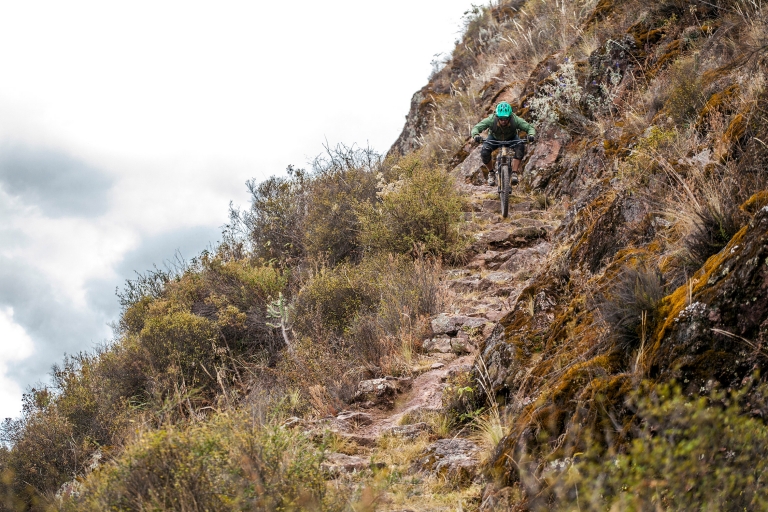
Located in the heights of the Andes near the city of Cusco, the Sacred Valley is full of Incan archeological sites, beautiful lakes and rivers, and some stunning (albeit chunky) trails. Photo: Diego del Rio
TSL: What motivates you to do that, Gabo? That sounds like a lot of work to convince farmers and ranchers and private landholders to get on board with your vision. How are you motivated to do that?
GB: One thing that was really cool, in La Gloria, most of the people that live there didn’t know about the highest part of the farm—it’s like the top of the mountain. When they saw us riding bikes up there, I say, “Yeah, I build a trail to the top.” “What?!” “Yes! I’m going to show you the top of your mountain. You have never been there?!”
When we open these kinds of spaces, the owners are happy. They know their place now, what they have and what they could do. When they’re walking a beautiful trail on their land, they are like, “Wow, this is beautiful.” “Yeah, this didn’t exist. We made it.” They start to see the potential that they have, and they can imagine the future with this.
We got one project I have been pushing for like five, six years, that is La Gloria. The owner is a great, great, great man called the “Capitán.” Of course, Capitán works his farm with all this crew that cuts the woods, but he gave us the opportunity to make these trails and to start developing this farm. It’s super big, and it’s close to a little town called Villa Ortega, a super little town. Now, we’re figuring out how we connect this town with all these places we want to protect. But we don’t want to go there and say, “We’re gonna do all this conservation and you can’t cut any more firewood here.” No, no, no, no. Let’s see how we could all share together because I know that in another 10 years, we’re gonna have more people maintaining trails than taking out woods.
If you don’t try it, you never know. Sometimes you win, sometimes you don’t.
TSL: Spoken like a true visionary. In parts of the US—including where I live right now in Rico, Colorado—outdoor recreation has become so popular that it’s become its own sort of extractive industry, where crowds damaging sensitive habitats and overwhelming local communities is a common trend we’re seeing. Do you fear outdoor recreation could become something similar for communities and environments in the Aysén region, and if so, in what ways do you think it could be managed?
GB: One hundred percent. I think outdoor recreation could be a big thing, big, big because we have everything. And I think the way to do that is working in these little towns and with kids. We’re losing localism. Kids, when they turn 15, 18-years-old, most don’t have the opportunity to go study. But nobody has shown them all the other things they have around. They have the mountains. I didn’t study anything. I live on this, and I am not a local. I don’t have a history here. They have everything, but we need to figure out how we give them the tools to realize that there is an opportunity because I know that not every one of those kids want to work on the farm.
And I’m not saying about that they’re going to lose their gaucho [South American term for “cowboy”] culture. No. They’re still gonna be gauchos, but in a different way. They’re never going to lose that culture. But if they don’t want to build fences, maybe they could hop over a mountain bike and guide or over a horse or walking or hiking or fly fishing. Why not? Why not? We need that. Give them the opportunity to know the sport, maybe know another language. But they have everything else. They have history. They are gauchos, and they’re gonna be gauchos over a mountain bike or over a snowboard.
I think that’s how we make that localism stay here and not go outside the region. Because it’s super easy for them go work on a fish farm or going to the mines. That’s the easier way. Or they come down to the city and we’ve lost them. We’ve lost a lot. It’s hard, but we need the spaces for them to do that.
I know that a trail system is more than having fun over the bike. That’s my view. I love to ride good trails, but I know that a trail is more than fun.
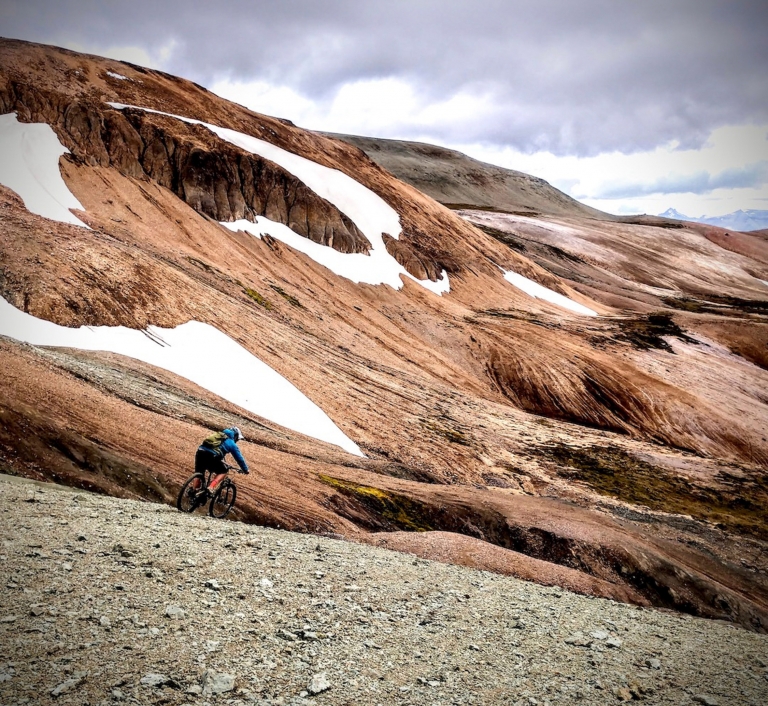
Gabo is well-versed in the Coyhaique region’s unique landscape; he not only lives in and runs multiple businesses in the area but also builds many of the area’s most popular trails. The alpine classic Chicken Line is one gem among many. Photo: Max Wittenberg
TSL: So, you are saying that the generations to come could manage these trails? And that staying there and having the passion for building those trails, or being guides in the area, and loving their place and the lands that they come from is going to help create education for everybody? And right now, you’re just trying to get your feet underneath you with trail networks in general, because there’s not much. Is that right?
GB: Yes, and that’s it. I think that’s what we need. I started realizing that, when I was a fishing guide, I looked around and thought, “There isn’t a new generation of guides. What are we doing wrong?”
We start doing this with all our businesses, in the tour company, then the store, then little things that help us bring all these together and try to support the trail builders. Now, we are trying to build a foundation working with these local communities. And more than focusing on Coyhaique city, I want to focus in little communities. That is where we have to go. I don’t want to say that in Coyhaique there’s no culture. Yeah, there’s a lot of culture. But it’s a big city. You have more opportunities.
In those little towns … that’s where you live in the real Patagonia.
TSL: That’s a lot of hard work, Gabo. I’m sure this past year has been a little bit crazy for you, as it has been for most of us. COVID-19 has disrupted life around the world, and we even had a delay in this interview because of the COVID-19 surge in Coyhaique. Can you tell me how the Aysén region is doing now?
GB: Well, this region receives a lot of tourists. So, all this season has been really, really hard. We didn’t receive any bike trips since March of last year. We’ve been through one year without working. But I’m happy that we just have the store, the bike shop. When we started the bike shop, we had nothing. I said, “OK, how are we gonna make it?”
The bike shop is doing really well now. We don’t have too many bikes, but we’re selling bikes, and it gives us a little bit to continue supporting all our team and that was super important for us.
We know that this is gonna end. I don’t know when, but I hope the next season is gonna be more like normal. A lot of people want to come, that’s true, and you could see that. We have to wait, be patient. There’s no option, just be patient.
Sometimes, I said, “OK, maybe I should stop.” No, I could not stop, I could not stop. This is for new generations, and one day all my trails are gonna be open for everyone. But somebody has to do it, and you cannot go to a place that’s not yours and open a trail for everyone and then make a mess. That doesn’t work. And this is so new here, that’s why. So, we have to take care about that.
I can see that because like 20 years ago, when we were starting into fly-fishing guiding, you could go everywhere. But then some guys start jumping inside the gates without permission, and some places were closed. Then that great lake when you go fishing, now you cannot get in. So, we have to make things right.
I know that all the trails I have been working on and paying for, I will never get that money back. I know that. But I’m so happy when I see that they can make a living doing that, and if we could give that little piece of help—that’s for all of us.
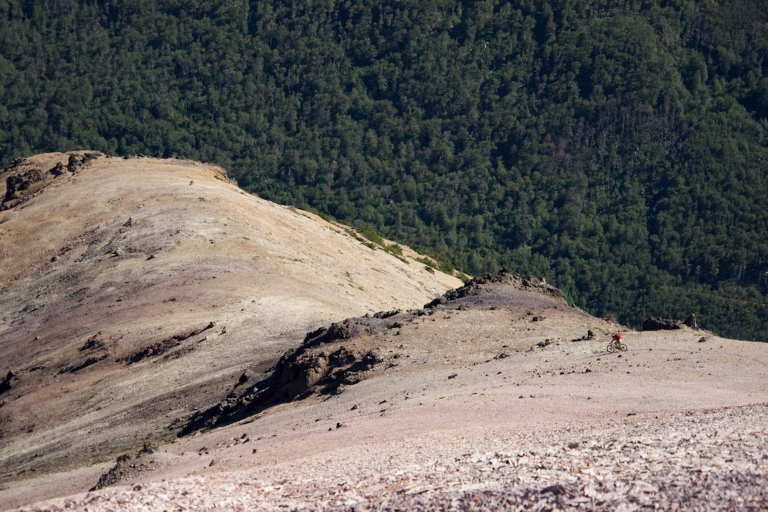
The terrain around Coyhaique is vast, and route-finding is its own challenge that usually involves traversing over multiple peaks and through multiple valleys in a single day’s ride. Photo: Max Wittenberg
TSL: I admire that so much about you, Gabo. In seeing the potential for being able to create more sustainable jobs in trail building. And having trail building be valued because it’s ultimately a way for people to get into the outdoors and learn about nature and learn about the places that they live. And I hear you say how challenging it is and luckily you have that professional mountain biker in you, that won’t give up. And this has been a wonderful conversation. Is there anything more that you’d like to add?
GB: I just do this because I love it. It’s not for ego. It’s not because I wanna be recognized. No, this is for everybody. I want to make something for the region. It doesn’t matter if my name is there or not. I love this. It’s my passion, it’s my life, it’s my lifestyle. And I hope I can push for that a lot of years more and try to change people minds to see that there are other opportunities. We live in an awesome place, and all Chile—it’s great.
It’s great to see how you motivate some people. For me, it’s so important to have Edecio and and Juan and the other trail builders. And maybe we are a little community here now, but we are real community. We are living doing what we really love, and that is mountain biking.
And this is for everybody. Trails for everyone, that’s it.
